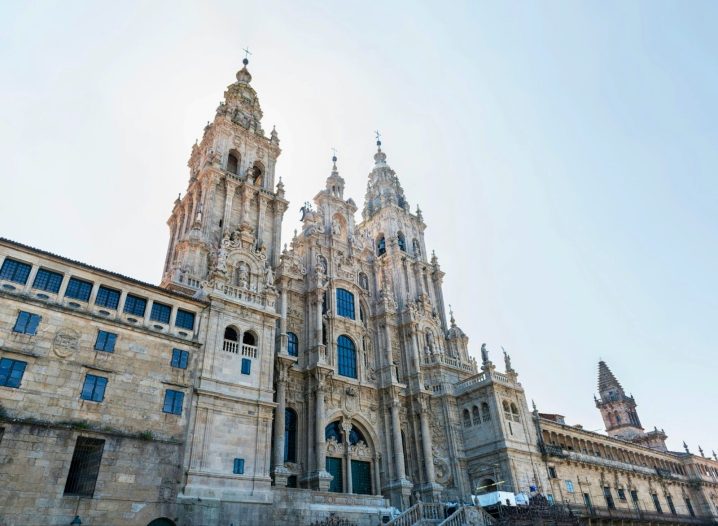If you are planning on visiting Madrid you can’t miss the Palacio Real. Discover why this famous landmark should be on your itinerary in this article
Palacio Real is one of the top destinations on Spain tours. It’s a must for history lovers with fascinating history and grandeur.
Throughout its numerous rooms and chambers, the Palacio Real showcases an unparalleled collection of art, furniture, and historical artifacts, reflecting the tastes and interests of Spain’s monarchs throughout the ages. From the sumptuously decorated Throne Room, where kings and queens held court, to the ornate Royal Chapel, where the Spanish royal family attended religious ceremonies, each space tells a unique story of royal life and legacy.
Constructed in the 18th century, the Palacio Real is a stunning example of Spanish Baroque architecture, with its imposing facades, intricate decorations, and opulent interiors. As you step through its grand gates, you are immediately transported into a world of regal luxury and artistic brilliance.

Upon entering the palace, you are greeted by the breathtaking sight of the grand staircase, adorned with intricately carved balustrades and adorned with magnificent frescoes. This monumental staircase sets the tone for the lavishness that awaits within the palace walls.
Walk through the opulent Throne Room, where echoes of royal audiences linger, and admire the intricate beauty of the Royal Chapel, witness to centuries of solemn ceremonies attended by the Spanish royal family. Every corner of this remarkable building tells a unique story of royal life and heritage, allowing you to uncover Spain’s captivating royal history.
One of the highlights of any visit to the Palacio Real is the Royal Armoury, home to one of the most extensive collections of arms and armor in Europe. Here, visitors can marvel at suits of armor worn by Spanish kings and warriors, as well as a dazzling array of weapons and military artifacts spanning centuries of Spanish history.
Beyond its architectural and artistic splendour, the Palacio Real is also steeped in political and cultural significance, having witnessed key moments in Spain’s history, from royal weddings and state ceremonies to diplomatic receptions and official banquets.
The Palacio Real’s vast and impressive collection of art includes works by some of Spain’s most renowned artists, such as Francisco Goya, Diego Velázquez, and Bartolomé Esteban Murillo. The palace’s Royal Painting Gallery houses masterpieces from these and other Spanish masters, offering a glimpse into the artistic heritage that has flourished under royal patronage.

Another fascinating aspect of the Palacio Real is its stunning architecture and design, which reflect the various artistic styles that have influenced Spain over the centuries. From the intricate Moorish-inspired details of the Patio de los Leones to the grandeur of the Throne Room, the palace’s architecture tells a story of Spain’s rich cultural and architectural evolution.
The palace’s Royal Pharmacy is also a testament to Spain’s scientific and medical history, with its collection of antique pharmaceutical jars, instruments, and documents dating back centuries. This well-preserved pharmacy offers a glimpse into the medical practices and traditions of the Spanish royal court and serves as a reminder of the palace’s role as a centre of learning and innovation.
One of the most striking features of the Palacio Real is its expansive gardens, which offer a peaceful retreat from the bustling city streets. The Campo del Moro Gardens, located behind the palace, provide a tranquil oasis with lush greenery, meandering pathways, and stunning views of the palace and the city skyline. These gardens offer visitors a chance to relax and unwind while soaking in the beauty of their surroundings.
As visitors wander through the palace’s opulent halls and galleries, they are treated to panoramic views of Madrid’s skyline and the sprawling gardens of Campo del Moro, providing a glimpse into the grandeur and magnificence of Spain’s royal capital.

The Palacio Real’s significance extends beyond its role as a historical monument; it also serves as a venue for official state ceremonies and events. From royal weddings to state banquets, the palace continues to play a central role in Spain’s modern-day monarchy, hosting dignitaries and heads of state from around the world.
Today, the Palacio Real continues to serve as a living symbol of Spain’s royal heritage, welcoming visitors from around the world to explore its treasures and uncover the secrets of Spain’s past. Whether admiring its magnificent architecture, marvelling at its priceless artworks, or simply soaking in the atmosphere of regal grandeur, a journey through the Palacio Real is an unforgettable experience that offers a deeper understanding of Spain’s rich and complex history.
The Palacio Real’s cultural significance is further enhanced by its proximity to other important cultural institutions in Madrid, such as the Teatro Real and the Almudena Cathedral. Together, these landmarks form a cultural hub that celebrates Spain’s rich artistic and architectural heritage, making the area surrounding the palace a must-visit destination for anyone interested in experiencing the best of Spanish culture.
In conclusion, the Palacio Real stands as a testament to Spain’s rich history and cultural heritage. From its stunning architecture and priceless artworks to its role as a venue for state ceremonies and events, the palace offers visitors a unique glimpse into Spain’s royal past and present. A visit to the Palacio Real is a journey through the heart of Spain’s royal history and a testament to the enduring legacy of La Dolce Vita.
Travelling onward from Madrid
Madrid is a fascinating city to explore and easily combined with Spain’s other cities. You can leave the historic wonders of Madrid and travel to the vibrant energy of Barcelona aboard the renowned train service connecting these two iconic Spanish cities. The train from Madrid to Barcelona offers picturesque vistas of the Spanish countryside as you leave behind the regal charm of the Palacio Real to explore the architecture of Gaudi, in one of Spain’s most exciting cities.

